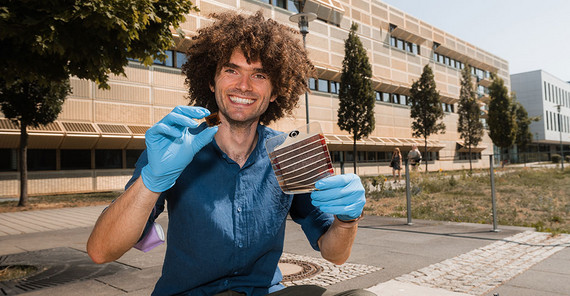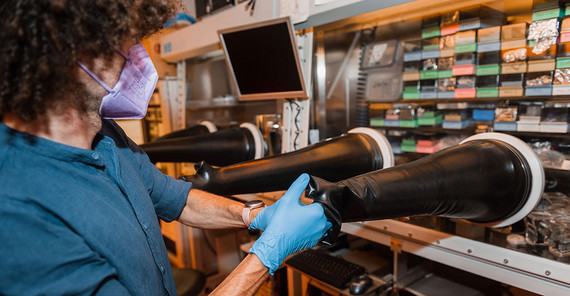For the applications Lang is researching, semiconductors must be particularly resistant to radiation. “The traditional approach has been to make harder and harder semiconductors,” he explains. “However, our soft semiconductors can withstand radiation exposure just as well because the material is able to repair damage on its own that is caused by irradiation or mechanical stress.” Semiconductors are substances that can be conductive or insulating, depending on external conditions such as temperature and perturbations in the structure of the atomic lattice. One of the most important semiconductors is silicon, which has a solid crystal structure that only functions when it has very few defects. Unlike silicon, however, the soft semiconductor perovskite has unusual properties: although it is crystalline, it has a flexible structure so that individual atoms can move and even jump from one lattice site to another. Unlike silicon, crystal defects hardly interfere with functionality. Solar cells made of perovskite have a high efficiency and at the same time can be manufactured easily and cheaply. “The temperatures required to produce perovskite solar cells are only 100 degrees Celsius, compared to 1,400 for silicon,” says Lang.
The challenge is that soft semiconductors cannot tolerate oxygen or water. Therefore, they are virtually predestined for use in space. Together with the Department of Astronautics at the Technical University of Berlin, Lang is developing solar cell prototypes that will be launched into space on board a nanosatellite, possibly as early as next year. Because everything cannot be tested on Earth, Lang is interested in how well the solar cells will perform under real space conditions. “One of my experiments will also fly on the European Space Agency’s Ariane 6, if everything works out,” he says.
Another area of application that the physicist is researching is medicine, where the only good radiation detectors that exist at the moment are very expensive. “The other day I went to the dentist for an X-ray and was very surprised that the image was still taken in analog on a film, which then had to be scanned in order to have a digital X-ray image,” Lang reports. “I would like to develop a detector that can measure the X-rays directly as a current, similar to a digital camera.” However, the materials needed to do this are so expensive to produce that they have few applications. With perovskite, you can get a higher-resolution image with less radiation exposure. This is particularly important in computed tomography, in which thousands of individual images have to be put together.
At the beginning, Lang didn’t realize that he would study physics. “I vacillated between medicine, physics and aerospace engineering,” he says. “But what I had been interested in since school were solar cells. Back then, I found it absolutely fascinating that I could generate my own electricity. I was in every physics club that was still going on in the afternoons, soldering things together in the school basement.” Then, while working on his doctorate, he tested perovskite for stability under radiation. “When I did the experiment, everyone had told me I was crazy: this is so soft, it's going to break. I tried it anyway.” With success.
For Lang, as a scientist, balancing research means switching off the computer and getting out into nature. “To clear my head, I do sports - hiking, cycling, jogging, swimming or kayaking. Then I can think about these problems again in peace,” he says. And while hiking, of course, he has a solar cell attached to his backpack to charge his cell phone.
This text appeared (in german language) in the university magazinePortal - Zwei 2022 „Artensterben“(PDF).


